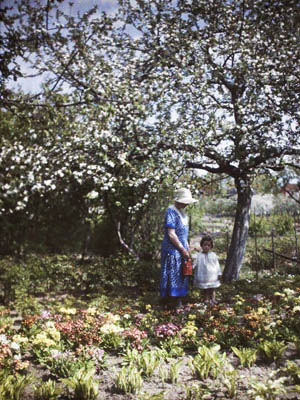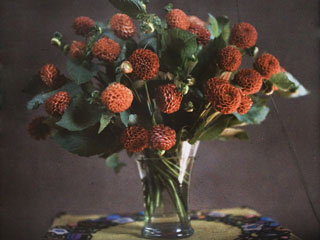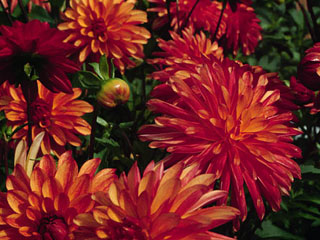Human Flower Project
Monday, December 18, 2006
Autochrome—And Gone to Heaven
In early color photographs of flowers, the ephemeral lives on.

Hausangestellte der Familie,
Roedenbeck Sehlde, 1928-1930
By Käthe Buchler
Image: MUSEUM FÜR PHOTOGRAPHIE
Flowers are not in rhythm with the tempo of these times—ever since we threw out the seasons and replaced them with switches. If something’s not instantaneous as a phone call or fixed as a monument, who knows what you do with it? This on/off, virtual-or-granite mentality, in our view, partly explains why flowers are being displaced as gifts. Bouquets are neither as permanent as knickknacks nor as consumable as wine or a massage. Like all living and dying things, flowers are in between.

Still Life with Dahlias by Käthe Buchler
Image: MUSEUM FÜR PHOTOGRAPHIE
In old photographs of flowers, you can see this quality, of being on the way. Take a look at the pictures of Käthe Buchler on view through January 14 at the Museum of Photography in Braunschweig, Germany. Buchler, working between 1913 and 1930, was an early color photographer. Her vases of dahlias and blossoming trees, so different from contemporary color pictures, look, truly, like flowers that have died and gone to heaven. The colors are muted but palpable. What they may lack in factuality, they regain in effect—blooms in the mind.
Buchler’s talent found a marvelous vehicle in the technique called Autochrome, one of the earliest methods of color photography. The Lumiere Brothers, who patented the process, used a mosaic of potato starch grains dyed yellow, red and blue, the gaps among them filled in with lampblack (a kind of root vegetable pixel). The image was projected through these grains onto glass, making dark but translucent positives best viewed like tiny stained-glass windows, with backlighting.
 Crazy Legs dahlias
Crazy Legs dahlias
Photo: L.R. Fortney
Compare Buchler’s picture of dahlias (above) with this very fine contemporary photograph, at left. Both are beautiful. (And these later flowers have doubtless gone on to heaven, too.) Why is the older one so much more elegiac and suggestive? The sensibilities behind them are different. One has the gift of accuracy; it has stopped an instant like a specimen, to keep for all time. In Kathe Buchler’s picture there’s a different kind of lasting —not a record of dahlias but a memory.




